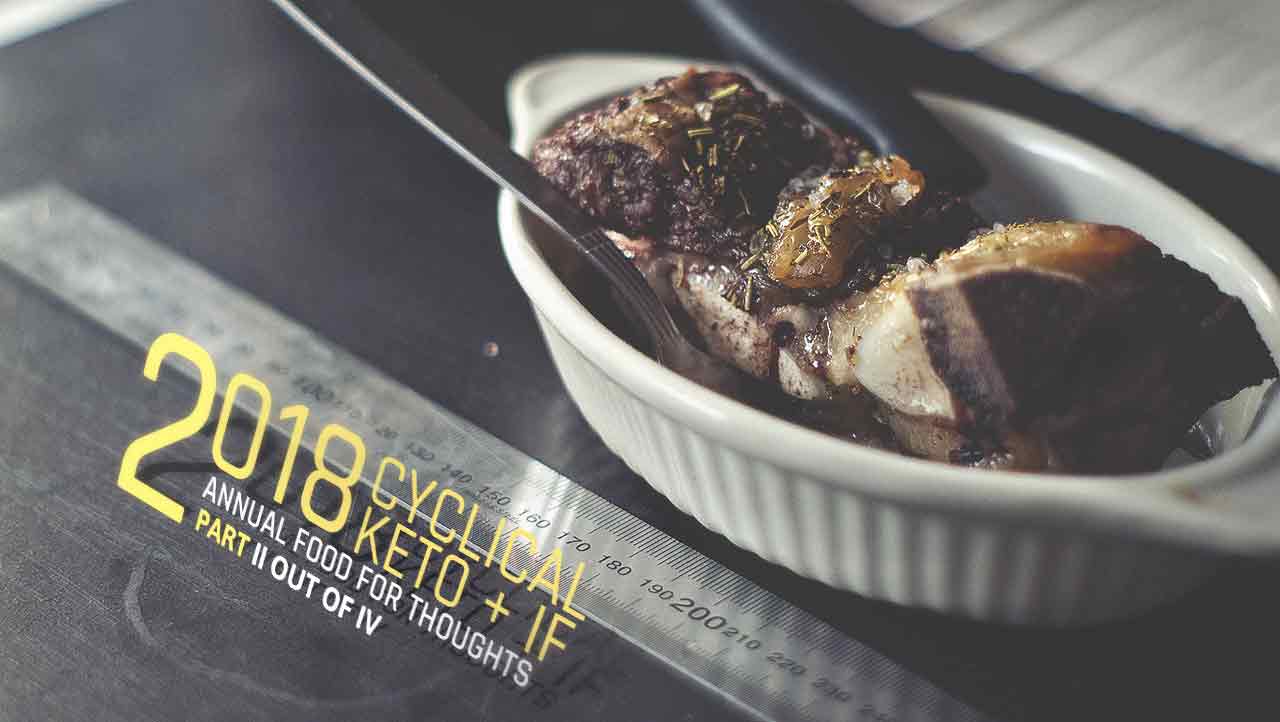
Fasting. Authentication. Inquire. Repeat

Cliff
Part 2/4: noteworthy updates & experiments from this year's mainly Cyclical Keto + IF sustenance on avg <$35 weekly expenditures.- This feature writing is entirely off my own personal viewpoint, perspective and thought(s) and may, subject to varying context(s) - introduce its own terminology(s) and/or themes readers may not readily be familiar with. Hence timely readership is well appreciated.
- This is an archived post which may or may not have undergone further editing for readership accessibility.
DISCLAIMER
You are reading someone else’s in-depth account/s of nutritional & life intervention/s spanning across ONE YEAR; covering everything from nutrition, psychology, supplementation and fitness training. All intertwined into both socio-economical and self-scientific (explorative) perspective. This is NOT a light reading. Don’t like it? Then go somewhere else. Pedestrian Normalcy welcomes you back with open arms.
Noteworthy findings & experiences.
In total I'm discussing eight (8) highlights:
- Vitamin A and its confusing importance.
- Incorporation of Gelatin.
- Monounsaturated fats = better sleep?
- <30g carb attempts: a blessing in disguise?
- Potassium Bicarbonate: not a safe potassium?
- Experimentation with PUFA intakes,
- Vitamin E: not just for PUFA damage control. And;
- Baking Soda; revisited.
Financial oppression sadly; gave me next to no room for other micro interventions.
1/8
Vitamin A - a confusing importance for gut health.
My research led me to realise that both Beta Carotene and Retinoic acids potentiates protective effects on the gut lining. I am calling this "confusing", because the two competing forms Beta-Carotene (deemed as "inactive" vegetarian sources) and the Retinoic Acids (deemed as "active" animal sources) - still remains open for debate to their bioavailability. Majority insists that Livers remains as the best source there is.
Another layer of confusion - individual genetics. Some literature suggested there are those who are able as well as not-so-able - converters from the inactive to the active form. Particularly, carriers of both 379V and R267S alleles were suspect to this conversion inability. Do I believe myself to be a "good" converter? This I don't know without resorting to expensive Google®'s 23andme DNA screening.
It is thought that Vitamin A status is augmented with dark leafy greens. But this study - found that hypothesis dubious.
...So what to make from all of this?
If I don't have Livers for dinner (sadly perplexed why beef livers have skyrocketed in price recently), then carrots & pumpkins are here to stay. At least on the basis of affordability. Taking it with plenty of fat encourages a better inactive -> active ratio conversion. How much of carrots or pumpkins do I actually use for each solid meal? Not a lot. Up to 60g of shredded carrot = nets 6 grams of carbs. Or 80g of butternut pumpkin dry weight: 8 grams of carbs.
By no means organ meats is given up. Over my dead body should anyone dare stealing my oven baked beef livers - with turmeric and minced garlic + butter gently cooked on the oven. I eat beyond for acquiring "taste". But also reconciling what humility and "respect" truly means; by consuming the most worthy parts of the animal as I wrote earlier.
2/8
Inclusion of Gelatin & Zinc for digestive resilience.
The quest for reducing my reliance of Betaine HCLs and Pepsin supplementations first led me to gelatin. It all began me pouring in about 10g worth of cheap Mckenzie's gelatin powder into my post whey workout shake, one cold evening of August. From there I almost immediately felt - a settling down process of digestion - that much sooner.
So compelled, weeks later I then decided to write an entire article on Gelatin alone. Alas - the biggest problem is that they can be quite costly. My existing unflavoured WPC protein supplies, mixed with flavoured ones remains my value-pricing benchmark.
Next, another such "long-forgotten" mineral that almost nobody reconcile its vast importance - is zinc.
Re-reading my (prior years of) Master Research & Notes sorely reminded me that zinc deficiencies' closely implications to that of gut and digestive function impairments. Also, I've found additional study collating all of Zinc's relevance to insulin action and liver health.
I can only describe how I "felt" - especially at a small dose before and during meal/s. A somewhat more noticeable "firming" of the gut. "Sturdier". Much less of sensation that something has "leaked". Very difficult to describe; as I doubt myself readily accomodating a $30,000 debt on biochemistry.
So how shall it be best taken? So far - still learning. I've tried semi-empty stomach state (as in combined with training preworkout BCAAs) as well as during and after presence of meals, in and out of - refeed days. Research wise, Chris Masterjohn - advised all zinc intakes should be done on an empty stomach away from foods rich in trypsin inhibitors and phytic acids. Surprisingly, my prior "bro-science" gospel in that whey (for it has calcium) interference with Zinc; seemed no longer plausible. As this study shows that whey proteins seemed highly synergistic with Zinc; at leveraging IGF-1 response.
Alas, financials remain oppressed nonetheless. A choice between short-dated avocados or 100g tub of gelatin? I'd choose the Gelatin. For the zinc - instead of downing oysters one after another knowing it cost $1 per serve - I'd rather scrape some coins for a 110 tablet worth of chelated zinc for three bucks (though beware this has calcium which may or may not limit its uptake) or a 90 serves of 200mg Zinc Sulphate; for 10 dollars.
Even though I did disclose in 2017 that Zinc Picollinate was once my preferred version of zinc - I am nonetheless still exploring which types I feel is amongst the best for me, and my wallet.
3/8
Monounsaturated fats = better sleep quality?
I found throughout this year that sleep / restorative quality seemed more convincing with monounsaturated fats. Particularly olive oils on main solid meals. But what about Saturated Fats? From butters and coconut creams and oils?**NEWS FLASH!!! Coconut oil is pure poison!!!!!*** Nevermind that pitiful sensationalism.
I am yet to understand why saturated fats (or how various types of fat) cause changes in sleep qualities. At least however, this study (based on mice) may shed some clues that saturated fats, but not unsaturated fats - impose changes on select genetic "clock" expressions. "Bmal1, Rev-erbα, and Per2" to name a few. It was needless to say, a technically verbose paper requiring some pre-existing knowledge which I am yet to understand them, unfortunately.
Worth mentioning are two key missing nutrients in wholefood sources of monounsatured fats (nut seeds, olives). They are Calcium, and (the arguably more so vital) - Vitamin K2.
I know all too well with every pedestrian's darling of all things "healthy" - kales - solely derives from its Vitamin K1. But the much more complex "FAMILY" of K2, from exclusively dairy sources - the MK7, MK4, and MK9-MK10, are almost absent from greens. Those complex forms of K2 seemed plausibly more important at reducing CVD risks than K1 intakes alone. Besides, K1 (again from kale, beet greens, silverbeets, etc) - needs plenty of fat for proper uptake.
So, my hunch for the best all-in-one solution? Gouda cheese. Apparently, the longer it's aged (13 weeks+) the better its K9 Menaquinone concentrations.
Katrin Leinfellner @ Unsplash.com
Besides better taste, with saturated fats - I feel more mentally attuned like a "sponge". Intermittently receptive (for the lack of better word) to anything informed at me. Similarly akin to my first experiences with ALCAR / Acetyl L Carnitine.
My problem however, is again tied to economics. The ALDI® Gouda Cheese (might not be on their website only in store) are $3.50 for only a mere 200g block (fit for 5 day usage at 40g serving). Next, the disappointingly inflated pricing of butters I witnessed this year sadly restricted me mainly to olive oils and peanut butters. I could recall a 250g salted pat costs an affordable two $ between 2015 and 2016. Now? It's three+ dollars.
At the very least, 95c Woolworths Coconut Creams; as I mentioned earlier for their excellent affordability - remains to be the only affordable staple of sat. fats next to normal block cheddar cheese. Otherwise, it's all predominantly olive oils, some (liberal, not too often) intake flaxseeds, walnut kernels and peanut butters (no added sugars).
4/8
<30g carb Keto attempts: a blessing or a curse?
My few "tests" amidst <30g intake of Keto/IF days - was somewhat of a blessing. Yet also sadly a worrisome experience. Mineral deficiencies symptoms. Slow breathing. The overall feeling of unease were all back in full force.
On the flipside, though yet to be confirmed causally - some pattern of digestion ease DID result from restricting my solid meal to just eggs, meat sources, the butter/oliveoils and condiments. This setup brought the immediate nutrient assimilation benefit I've felt compared to recent memory. At times also I was convinced it was during these near zero-carb attempts, if for as long as protein intakes are high enough - <30G of carb attempt days enabled me to survive being the leanest. Whilst visible muscle losses were noted less, though of course physically unavoidable.
But at what cost? the return of mineral deficiencies symptoms above; forced me to re-evaluate my thoughts. Thereby seeking and trying - other types of magnesium and potassium soon afterwards.
5/8
Potassium bicarbonate, the worst potassium? Magnesium malate: yet to be convincing.
Starting off with Potassium Bicarbonate (or 'PBC' or 'K/Bicarb' as I shortened it) - current medical literature praises it a lot. It surpasses the good old baking soda for reducing urinary calcium excretion (...does that meant more calcium retention?). Anecdotally, Potassium Bicarbonate garnered effective control against those experiencing excessive diarrhoea from other forms of potassium (namely citrate).
Unfortunately, I had many adverse reactions from K/Bicarbonate. The many episodes of tightness in the chest, with slow breathing patterns made me wary. In both fasting and inbetween feeding windows. With water, without water, on coffees, or just tiny finger lick amount. I could recall one Wednesday night surpassing my twenty hour fasts - whilst grocery shopping the next $30 week's budget I almost fainted as I browsed the aisle. I literally had to brace myself to keep myself awake.
Next - Magnesium Malate - often praised to be a superior form due to its malic acid at supporting the Krebs Cycle, as well as promoting a detoxifying process against heavy metals; particularly alumunium. But in practical terms and use how do I feel out of this? Not convincing enough of response yet, sadly. At least this does not impose that excess laxative effect as per the notorious Oxides form do.
What about the energetic (or ergogenic) part of it? Some seemed to report its overstimulating effect. Throughout weeks of using it on/off as preworkout aid - so far I am finding it somewhat difficult to find any distinct benefit throughout my training windows.
Perhaps, I shall stick to what I am familiar with. The nanohydrate based magnesium citrate ("Magnesium Forte" by bioorganics). Because it also provide manganese (one of few minerals which helps offset the excess zinc dominance) as well as vitamin B6 (being synergistic with Zinc). For my go-to potassium source - it has simply been the minute sprinkle of Cream of Tartar / Potassium Bitartrate. It is tasteless (though if mixed with black coffee somewhat appears to have "cream" like palate), and at only small finger pinch amounts - already gives 247mg of potassium.
In spite of all that I am still learning.
Kilian Peschel @ Unsplash.com
6/8
Experimenting with Omega 6 PUFAs on Cyclical Keto + IF.
I wrote an entirely separate article; calling for a strong re-evaluation on our understanding of Omega-6 PUFAs. Yes the industrialised "666" of agriculture. The heretics of all things "health" and "fitness".
I thought; why not put myself to the test. For a few Cyclical Keto/LC+IF week/s on and off intermittently using PUFAs as Nuttelex® sunflower spread (how colourful and bright the packaging!) The PUFA concentration is as according to the packaging is 41% sunflower (17.5g saturated, 24g poly, 23.4 unsat). I'm also using Heinz Garlic Aioli. Both sounds plentiful enough of PUFA to me (the 65g of fat per 100g content in the Heinz® Aioli is only 5 grams as sat fats).
Also to ensure higher Omega-6 to 3 ratio throughout these sporadic experiments I've upped the intakes of both flaxseeds and walnuts (though quite a sorry on my wallet) anywhere between 20 to 30 grams huge combo lots as per to my digestive comfort.
How did it go? ...Not very good. On my first full 5-day-pledge of Cyclical Keto+IF on predominantly PUFAs - I felt more susceptible to feel sick. As in groggy throats, stuffy noses, and excess mucus. These seems persistent almost without fail; wherever PUFA's on the meal.
Worse - training windows seemed adversely affected. During my 5x5 to 6x6 limited rest training across up to 12 exercises - I felt tightness within regions of the chest which were not there before. Especially among tension hold machine eccentrics. ISOLAT-DY Back rows, ISOLAT-Front lats with overhand (bicep) grip seemed repeated suspects.
At times, heartburn and overall tightness sensations were more prevalent than if I were to use less PUFA oriented fats. Betaine HCLs and Pepsins certainly did help, but I still aim to reduce my reliance on it. Amongst refeed days of (light of course) PUFA intakes I also noted surprisingly - that upon Mondays and Tuesdays - there were much less bowel movements.
My verdict? Given from my sparse experiments (on/off with various concentrations) thus far, perhaps it's likely a "no" for me. However, by no means that I am giving up other very specific form of PUFAs - some liberal flaxseeds, and not forgetting also - copious amount of selenium vital for thyroid function from brazil nuts. Besides, they complement as crunchy companion next to my (next revised!) humble DIY whey cheesecakes.
7/8 Vitamin E - not just for damage control.
Having done the above delirious self-experiment, I am obviously concerned with the many theories over PUFA's notorious inflammatory effects. Hence prompting me to supplement Vitamin E. The dosages found in commercial shelves however are hilariously high (250IUs being the smaller amount) - hence I only take up to four in total each week.
The strangest effect I am yet to understand why - is that Vitamin E helped improves sensory and palatability perception in ALL FOODS.
Searching for any medical literature on this phenomenon sadly returns with almost nothing. But one paper suggests Vitamin E's possible relevance to taste buds and olfactory sensory mechanisms. That study sadly, is not for free-reading unless purchased.
Further that, interestingly - I have experienced strangely very FAST - hair growth whenever I supplement Vitamin E. This is not a joke. I expect to do my DIY-Undercut-Fades ritual/s approximately once every four & half weeks. On sporadic Vitamin E supplementation? As often as once every TWO and half (2.5) weeks.
8/8 Baking Soda; revisited.
Last noteworthy exploration this year (as well as the previous) is me revisiting Baking Soda. Whether it'd be a pinch in my black coffees during fasting window, 2 heaped teaspoons as preworkout aids or on refeed cereals, or even with /pwo shakes = I do feel some elusive effects from it.
Many literatures claiming Baking Soda's benefits - from improving insulin sensitivity, ergogenic preworkout aid, and increasing bodily CO2 levels. All indeed sounds intriguing. I myself confirmed a greater - muscle glycogen uptake in mixing whey shakes with it especially during refeeds. Referring back to Lyle McDonald's Ketogenic Diet (page 47) shared a study suggesting that a rise in Ph from supplementing sodium bicarbonate does help prevent protein breakdowns.
More baking soda seems good then right? I remain ambivalent. Tinkering various intakes throughout Cyclical Keto, now IF, during and out of refeeds - I notably experienced some unexplainable light aches in joints within just everyday mobility. Especially when sipping my Warmed Apple Cider Vinegar +Baking Soda + hot water drink. One study may shed some light that perhaps it is the bicarbonates that may compromise bone mineral density.
And what about the gastric GI stress effects? Yes I do experience mildly as such. Obviously not as severe as this anecdote. This just confirms that "nature" is never benign.
I no doubt willingly praise it as an "essential" preworkout aid next to creatine + ALCAR. But unfortunately also almost without fail - I experience constant burrping during ALL training windows. That is, mixed with or without - commercially sweetened products - BCAAs / various preworkouts / beta-alanines. Perhaps the so called "adaptation" process is required akin to Creatine's twenty (20!!) grams worth of "Serial Loading". However, "Serial loading" of anything - in my opinion - is mildly abusive. In that I cannot predict the readiness of my state of gut at preparing such a huge dosage in one go.
In short Baking Soda, however seemingly essential be it Keto or non keto - remains noteworthy to be experimented.


